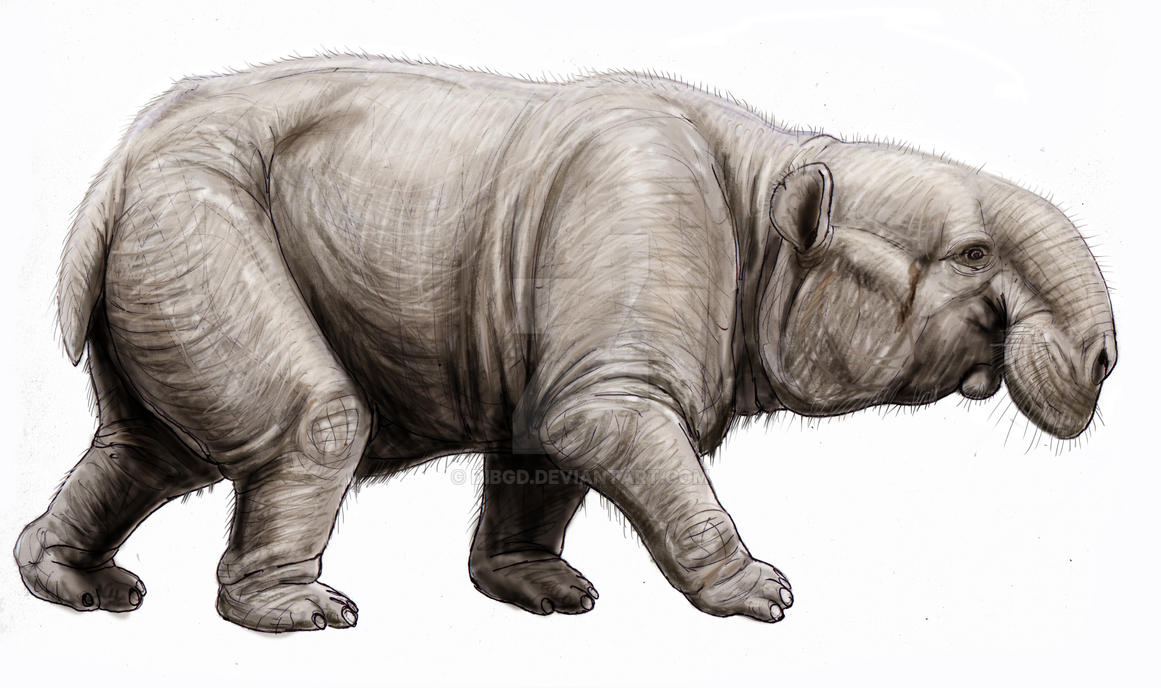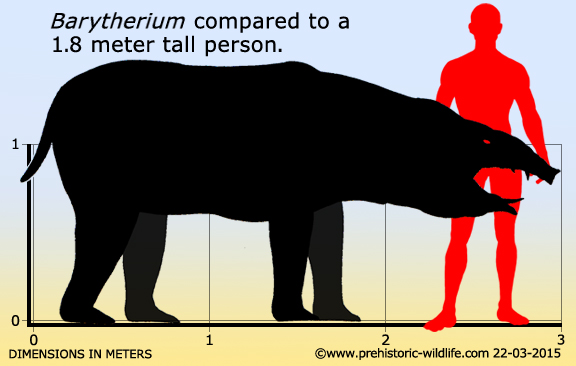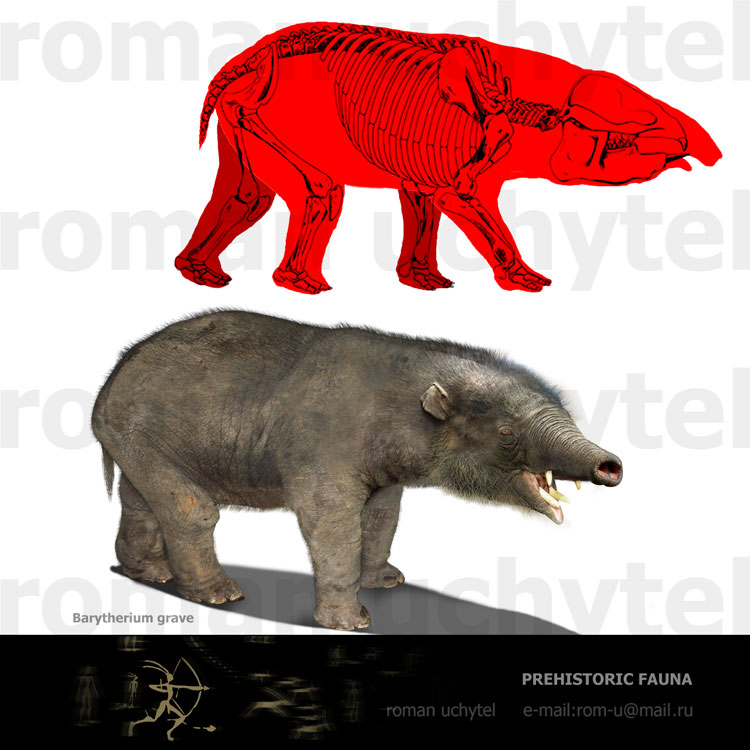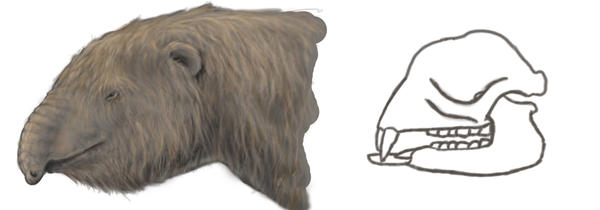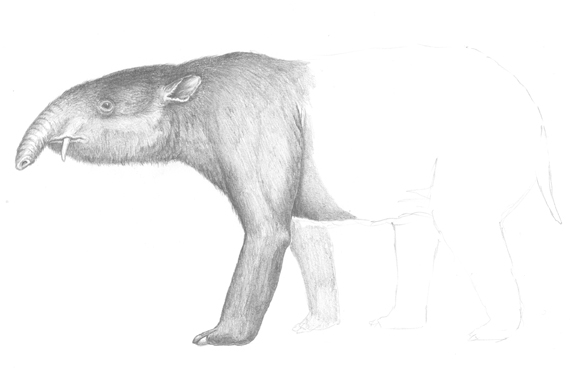Barytherium
- Barytherium grave
Barytherium is an extinct genus of Proboscidea; she lived in the late Eocene and early Oligocene around 37-33 million years ago. She was confined mainly to the northern Africa and the Arabian Peninsula. Members of this genus were distinguished by the presence of eight tusks. The term Barytherium is composed of the Greek words βάρος ( Baros, heaviness or weight) and θηρίον ( THERION, animal) and refers to the previously proven for the first time in the trunk TieRevolution significant size and weight gain of the animals.
Features
Barytherium is a relatively large animal with a trunk. It reached a shoulder height of 2.5 to 3m and weighed an estimated 3 to 4 t. Thus, it was significantly larger than the evolutionarily older, only tapirgroße Moeritherium. In general, it is characterized by an elephantine physique and the columnar limbs. But the thigh (femur) showed lateral flattened. The skull was flat and only slightly arched, but rejected as all later proboscids also air-filled chambers in the skull, which reduced the weight of the entire head clear. The nasal opening was large and laterally highlighted what is interpreted as the attachment point for the trunk. About size and appearance of the trunk but nothing is known.
The mandible was made solid and had a very extensive symphysis, which reached to the first molar. The teeth showed over the older Moeritherium on the reduction of an incisor and the canine in each pine bough and was hence already a significant further developments represents the dental formula for adult animals was:. Behind the second incisor was a large diastema. The molars had a lophodonten structure, with the premolars had only singular cross bars. The molars, however, were characterized by two bars, and thus showed a typical bilophodonten construction.
Most notable in Barytherium however, were the incisors, which were converted into tusks. The animals per arch had two tusks, a total of eight. The tusks of the upper jaw were sitting square to the jaw bone. Here, the outer tusk (I2 ) was significantly greater than the inner ( I1). In contrast, the tusks of the lower jaw had a horizontal position. In addition, here the inner tusk (I1 ) was significantly larger designed as outer (I2 ). Due to the position and shape of the tusks a kind of gap between the inner surface of the upper second incisor and the outer surface of the lower first incisor was born.
Paleobiology
Widespread was Barytherium during the Eocene - Oligocene transition on today's North Africa and the Arabian Peninsula, which was still connected to the African continent. The life of Barytherium has long been unclear. Isotope studies of teeth of new finds from Egypt now enabled a reconstruction. Barytherium lived in hot and humid tropical rain forests on the banks of freshwater lakes. Interestingly, had the enamel to a relatively constant proportion of the heavy oxygen isotope 18O which, although more varied than that of marine mammals but was more balanced than in terrestrial mammals. As a rule, he had variances today semiaquatic rural residents. It is now expected that Barytherium had a relatively limited habitat and rarely changed the location. It probably spent a large part of the day in the water of the surrounding lakes and fed on the local water plants or near-shore phytoplankton.
Fossil finds
Finds of Barytherium are relatively rare. The first finds release in early 20th century in the Al- Fayyūm Valley in Egypt, where most of the finds come from. You lie there in the Birket Qarun - formation, the Qasr el- Sagha lineup and the Gebel - Qatrani lineup, which date from the Upper Eocene to the Oligocene. The finds from El- Fayyum were almost 60 years, the only known of Barytherium. Only in the 1960s and 1970s came to Dor el Talha in the Sirte Basin in Libya, another important finding place, several, some complete skeletons revealed. Here it is demonstrated in the evaporite unit and the Idam Unit. Further evidence comes from Aidum Governorate of Dhofar in Oman.
System
Barytherium was first described on the basis of finds from Al- Fayyūm by Charles William Andrews in 1901. Due to the bilophodonten structure of the molars and the detectable vertical dentition the genus clearly belongs to the group of primitive Plesielephantiformes, of which the more developed higher Elephantiformes by a higher number of different melting strips on the teeth and the horizontal change of teeth. Within this, it belongs to the family Barytheriidae. However Barytherium shows the reduction of the outermost incisor and the canine as well as with the appearance of a large diastema been significant advancements over older Rüsseltier forms as Numidotherium, Daouitherium or Moeritherium and is in a closer relationship to the Deinotherien. However, it is not regarded as the immediate ancestor, since they have a more complex structure of the molars. Most likely, it forms together with the end of the 2010s newly discovered Arcanotherium an outside group of Deinotherien.
The position of Barytherium within the Proboscidea was often contested over the history of research. Andrews himself created the taxon Barypoda (also Barytheria ), which he to the Amblypoda, putative early ungulates introduced, until 1906, he pointed them as family Barytheriidae the proboscis animals. The American paleontologist and Rüsseltier expert Henry Fairfield Osborn (1857-1935) was divided Barytherium out again and put them back into the taxon Barytheria, as well as various other researchers. Today Barytherium is considered as a unique member of the mammoths.
Barytherium grave is that described by Andrews elephants large type species. A possible second type of Dor el Talha has been mentioned. This is much smaller than Barytherium grave and only reached a shoulder height of 1 to 1.5 m at 200 kg body weight. It was found in the deposits of Obereozäns. A possible third, also not yet described species was discovered in the late 2010s in Al- Fayyūm and is intermediate between the small and the large Art Dating back to the earliest Upper Eocene ..




